Economic Importance
Plant Kingdom of Class 11
Phycocolloids
A number of phycocolloids are extracted for commercial use. These include agar, carrageenin and funori. Agar is used in solidifying laboratory culture media and is added as stabilizer or thickener in the preparation of jellies, puddings, creams, cheese, bakery, etc. Agar is obtained from Gelidium and Gracilaria. Carrageenin is used as a clearing agent in liquors, etc. It is extracted from Chondrus. Funori is a glue used as adhesive and in sizing textiles, papers, etc. It is got from Gloiopeltis.
Food
A number of red algae are edible, e.g., Porphyra (Laver). Porphyra is cultivated in Japan for commercial exploitation.
Medicines
Corallina has vermifuge properties while Polysiphonia is antibacterial. Carrageenin hastens blood coagulation.
Phaeophyceae : Brown Algae
Brown algae comprise about 2,000 species.
Most of the brown algae are marine, except three-Pleurocladia, Heribaudiella and Bodanellia, which are found in fresh water.
Unicellular forms are absent. The body consists of a branched filamentous structure in lower forms (e.g., Ectocarpus) and parenchymatous structure in higher forms (e.g., Sargassum, Laminaria, Fucus and Macrocystis).
Brown algae include the largest algae. The giant brown algae are called kelps. The largest kelps are Macrocystis (40-60 m), Nereocystis (20-30 m) and Laminaria (2-9m).
The plant body is often differentiated into holdfast, stipe and lamina. The algae are commonly found attached by means of their holdfasts. A few species of Sargassum and Fucus are free floating. Sargassum species (e.g., S. natans, S. fluitans) floating on the sea surface cover a large area in parts of North Atlantic Ocean. The area is popularly called Sargasso sea. Free floating forms can be menace to shipping as they get attached to the bottom of the ships.
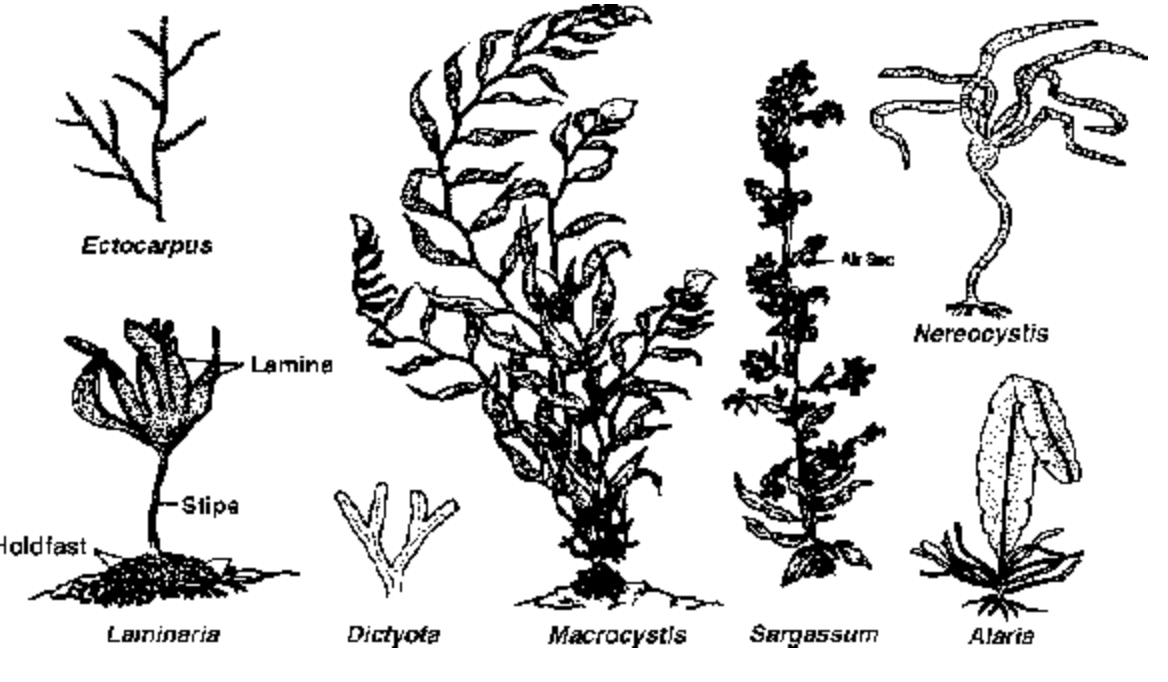
Fig. Some Brown Algae
Cell wall contains cellulose, non glycan polysaccharides and phycocolloids. Phycocolloids of brown algae are non sulphated mucosaccharides. The common ones are alginic acid, fucoidin and fucin.
The photosynthetic pigments are chlorophyll a, chlorophyll c, β-carotenes and xanthophylls (e.g., lutein, flavoxanthin, violaxanthin). The brown colour of brown algae is due to the presence of large amount of xanthophyll called fucoxanthin (C40H56O6).
Food reserve is laminarin (starch) and D-mannitol (a sugar alcohol).
Conducting tubes or trumpet hyphae are present in larger brown algae or kelps.
Vegetative reproduction occurs through fragmentation (e.g., Sargassum), adventitious branches, stolons (e.g., Dictyota).
Asexual reproduction occurs with the help of both motile (e.g., zoospores) and non motile spores (e.g., neutral spores, tetraspores, and monospores).
Sexual reproduction varies from isogamy to oogamy
There is no zygotic meiosis in brown algae. The diploid zygote produces a diploid thallus.
Isomorphic alternation of generation is found in some brown algae, e.g., Ectocarpus, Dictyota.
Chlamydomonas
It is a common fresh water algae. Plant body unicellular, motile, biflagellated.
Flagella are two, isokontae, whiplash type.
Cell contains a single nucleus, two contractile vacuoles, a cup shaped chloroplast with a red eye spot or stigma lies at the anterior end. Chloroplast contains single pyrenoid.

A Chlamydomonas plantNeuromotor apparatus of Chlamydomonas
Reproduction : Asexual & sexual.
(I) Asexual : By following spores.
- Zoospores : Naked biflagellated asexual spores, produced during favourable period. number of zoospores 4-8 per cell.
- Aplanospores : Thin walled, non-motile spore.
- Hypnospores : Thick walled, perennating non-motile spores. causing red snow due to haematochrome.
- Palmella stage : Daughter cells produced by division of protoplast and surrounded by mucilage.
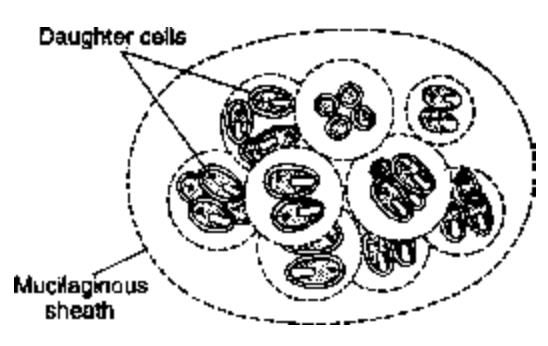
Palmell a stage
(II) Sexual reproduction :
- Isogamous : Fusing gemetes are similar morphologically and different physiologically. Gametes are biflagellated eg. C. debaryana.
- Anisogamy : Gametes are different morphologically as well as physiologically eg. C. braunii.
- Oogamy : Most advanced type. Fusing gametes are different both morphologically as well as physiologically eg. C. coccifera.
- Hologamy : Directly youngcells fuse. eg. C. media.
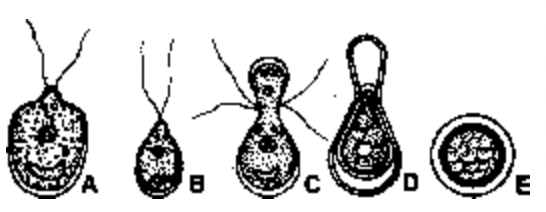
Sexual reproduction : Anisogamous in C. brauni
A. Female gamete, B. Male gamete, C. Male and female gametes join together, D. Fusion of Protoplast, E. Zygote
Ulothrix :
Fresh water benthic alga, found in moving water of slow streams.
Plant body : Filamentous, unbranched filaments having 3 types of cells.
- The basal colourless rhizoidal cell called hold fast, meant for attachment.
- Middle cells
- Dome-shaped apical cell.
- Each cell contains a central nucleus a girdle shaped chloroplast with one (U. rorida) or more (U. zonata) pyrenoids.
- Cytoplasm forming a thin layer called primordial utricle” to which nucleus is attached.
Reproduction
Vegetative : By fragmentation
Asexual : By the formation of following spores.
Zoospores : produced under favourable conditions.
Following 3 kinds of zoospores are produced.
- 56Biflagellated microzoosporse.
- Quadriflagellated microzoospores.
- Quadriflagellated macrozoospores.
Aplanospores : Thin walled non-motile.
Hypnospores : Thick walled, non-motile.
Palmella stage : In few species colonies of daughter cells surrounded by mucilaginous sheath are produced in moist conditions.
Sexual Reproduction
Isogamous type occuring at the end of the growing season.
Filaments are heterothallic mostly.
Gametes are motile, biflagellated smaller than biflagellated zoospores.
Fertilization is external and fusing product is quadriflagellated diploid zygote (2n).
After a period of swimming, zygote discards its flagella and is surrounded by a wall to form zygospore.
After a long period of rest, it divides meiotically to form 4-16 meiospores, each one developing in to a new plant.
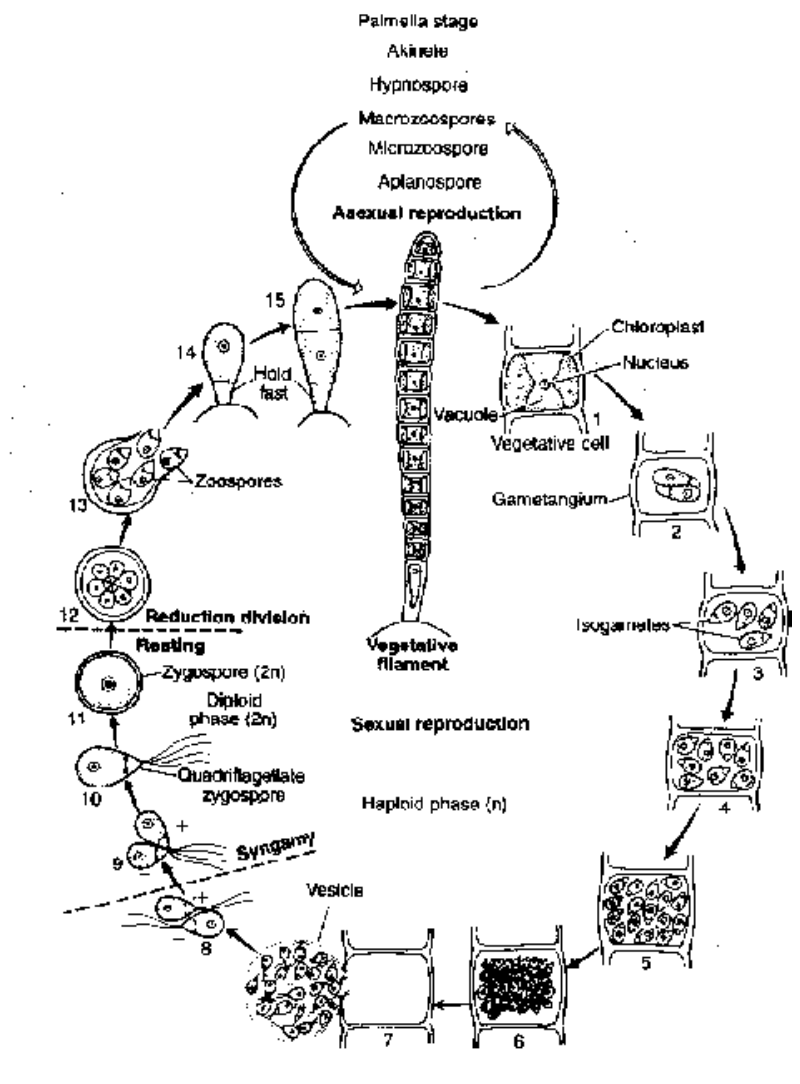
Ulothrix : Diagrammatic representation of life cycle
Spirogyra (Pond Silk)
Fresh water alga, found in stagnant water of pools, ponds and ditches.
Plant body : Filamentous, unbranched.
Rhizoidal cell is absent except S. adnata
All cells of the filament are similar.
Cell wall consisting of outer layer of pectin and inner layer of cellulose.
Protoplast differentiating into plasmamembrane, cytoplasm, a single nucleus (remains suspended in the vacuole with the help of cytoplasmic strands.
Chloroplasts spiral band shaped (1-16 per cell) with pyrenoides (1-16 per chloroplast)
Reproduction :
Vegetative : By fragmentation. It is the most common method of reproduction.
Asexual reproduction : Generally absent, but has been observed rarely in few species only.
Sexual Reproduction : Isogamous type, it occurs by conjugation. Conjugation of following two types.
Scalariform conjugation :
- It is more common and advanced type.
- It occurs in both homothallic and heterothallic species.
- A conjugation tube is formed between the cells of two filaments through which male gamete migration by amoeboid movement and fuses with the passive female gametes in the opposite cell to form a diploid zygospore eg. S. cylindrica.
Lateral Conjugation :
- It is primitive and can be direct and indirect type.
- Occurs in homothallic speices.
- In indirect lateral conjugation male gamete passes through conjugation tube formed between two adjacent cells. eg. S. affinis.
- In direct lateral conjugation, male gamete passes through a pore in the intervening cell wall between the two adjacent cells of the same filament, eg. S. jogensis.
- The fusion product is a diploid zygospore (2n)

Spirogyra : Diagrammatic representation of life cycle
Germination of zygospore
- Zygospore has a 3 layered cell wall differentiating into outer exospore, middle mesospore and inner endospore.
- The diploid nucleus of zygospore divides meiotically to form four haploid nuclei. Three of these degenerate and one remains functional which gives rise to a new filament.
Economic Importance
Food
A number of brown algae are used as food in some countries, e.g., Laminaria, Macrocystis and Sargassum. The edible brown algae are also used as fodder. Food obtained from Laminaria saccharina is known as kombu.
Iodine and Potash
Fucus and Laminaria are rich source of iodine. Potash is abundant in Macrocystis and Nereocystis.
Medicines
Sodium laminarin sulphate obtained from Laminaria is an effective blood anticoagulant. Laminaria, Pelvetia and Ascophyllum have antibiotic properties, while Durvillea has worm expelling properties.
Alginic Acid
It is phycocolloid which is obtained commercially from a large number of brown algae including the giant ones (e.g., Laminaria, Macrocystis, Nereocystis, Fucus, Sargassum). Alginic acid and its salts are used in obtaining emulsions (ice creams, ointments, tooth pastes, cosmetics, creams, shampoos, etc.), flame proof plastics and surgical threads.
Chlorophyceae : Green Algae
About 90% of the total species grow in fresh water habitats and 10% are marine. They are cosmopolitan in distribution. They may be
Terrestrial – growing on moist soil, walls and rocks, e.g., Ulothrix, Vaucheria etc.
Epiphytes – growing on other plants, e.g., Trentopohlia, Protococcus, etc.
Endophytes – growing inside the other plants, e.g., Coleochaete nitellum inside the thallus of Nitella.
Epizoic – growing on the surface of animals, e.g., Cladophora and Characium on mollusc shells and Crustaceans, respectively; Trichophilus on fur of American tree dwelling mammal called scoth.
Endozoic – living inside body of animals, e.g., Zoochlorella inside sponges, Chlorella in the body of Hydra.
Cryophytes – growing in the polar region on ice and snow, e.g., Chalmydomonas nivalis, (causing red snow ball).
Thermophilic – growing in hot springs, e.g., Chlorella sp.
Parasitic – growing as pathogens and causing diseases, e.g., Cephaleuros (causing red rust disease of tea and coffee).
Symbionts – as components of certain lichens.
Thallus is of various types : unicellular flagellate (e.g. Chlamydomonas), unicellular non flagellate (e.g., Chlorella, Acetabularia) or flagellate colonies, (e.g., Volvox), non flagellate colonies (e.g., Hydrodictyon), coenocytic and siphonaceous (e.g., Vaucheria), unbranched filament (e.g., Ulothrix), simple branched (e.g., Cladophora), heterotrichous (e.g., Draparnaldia), and parenchymatous (e.g., Ulva).
Cell wall contains cellulose.
Photosynthetic pigments are similar to those of higher plants: chlorophyll a, chlorophyll b, carotenes and xanthopylls.
Food reserve is starch.
Chloroplasts generally contain pyrenoids for storage of starch.
Asexual reproduction takes place by mitospores. The common asexual spores are zoospores, aplanospores, hypnospores, akinetes, etc.
Sexual reproduction is effected by isogamy, anisogamy and oogamy.
Three types of life cycles occur in green algae : haplontic, diplontic and diplohaplontic.
In haplontic life cycle the dominant phase is haploid. The diploid stage is present only in the form of zygote or zygospore. Meiosis occurs at the time of its germination of zygote (zygotic meiosis, e.g., Ulothrix, Spirogyra and Chalmydomonas).
In diplontic life cycle, the dominant phase of the alga is diploid. It gives rise to haploid gametes through meiosis (gametic meiosis, e.g., Caulerpa). The gametes fuse and the fusion product or zygote regenerates the diploid phase.
The haplodiplontic life cycle possesses well developed multicellular haploid and diploid structures. e.g., Ulva, Cladophora.
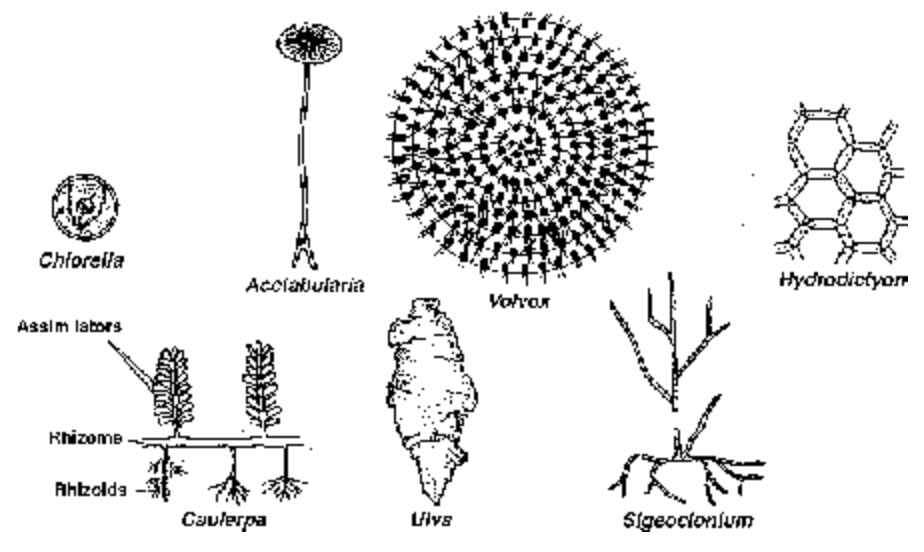
Fig. Some Green Algae
Economic Importance
Chlorella produces food rich in proteins fats and vitamins. It also yields an antibiotic chlorellin. Chlorella can be used in prolonged space flights for food, oxygen, disposal of CO2 and organic matter.









